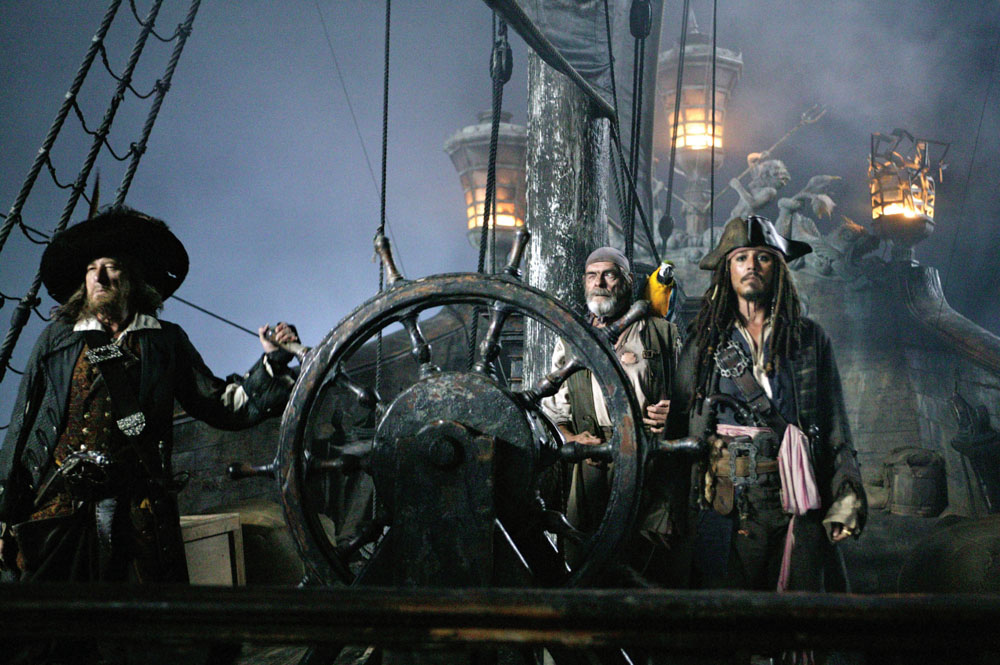
Pirates of the Caribbean: Dead Man's Chest is a 2006 American fantasy swashbuckler film directed by Gore Verbinski, written by Ted Elliott and Terry Rossio, and produced by Jerry Bruckheimer. The sequel to Pirates of the Caribbean: The Curse of the Black Pearl (2003), it is the second installment in the Pirates of the Caribbean film series. Set one year after the events of The Curse of the Black Pearl, the film recounts Captain Jack Sparrow owing a debt to Davy Jones (Bill Nighy), the ghastly captain of the Flying Dutchman, and is marked for death and pursued by the Kraken. Meanwhile, the wedding of Will Turner (Orlando Bloom) and Elizabeth Swann (Keira Knightley) is interrupted by Lord Cutler Beckett (Tom Hollander), who wants Turner to acquire Jack's magic compass in a bid to find the Dead Man's Chest.
Two sequels to Pirates of the Caribbean: The Curse of the Black Pearl were conceived in 2004, with Elliott and Rossio developing a story arc that would span both films. Filming took place from February to September 2005 in Palos Verdes, Saint Vincent and the Grenadines, Dominica, and The Bahamas, as well as on sets constructed at Walt Disney Studios. It was shot back-to-back with the third film of the series, At World's End (2007).
Dead Man's Chest was released in the United States on July 7, 2006, and received mixed reviews, with praise for its visual effects and Depp and Nighy's performances, but criticism for its running time and plot. The film broke several records at the time, including the opening-weekend record in the United States with $136 million, the fastest film to gross over $1 billion at the worldwide box office (63 days), became the highest-grossing film of 2006, and was the highest-grossing film produced by Disney until it was surpassed by Toy Story 3 in 2010. The film received four nominations at the 79th Academy Awards (winning Best Visual Effects).
PLOT
The wedding of Will Turner and Elizabeth Swann is interrupted by Lord Cutler Beckett of the East India Trading Company, who arrives at Port Royal with arrest warrants, charging them for setting Captain Jack Sparrow free. Despite also having a warrant, Commodore James Norrington resigned from the Royal Navy and disappeared after losing his ship, the HMS Dauntless, in a hurricane while pursuing Jack.
Meanwhile, aboard the Black Pearl, Jack is visited by Will's father, Bootstrap Bill Turner, and is marked with the Black Spot. Bootstrap is a crewman on the Flying Dutchman, captained by Davy Jones. Jack previously bartered a deal with Jones to raise the Pearl from the depths, and must now serve aboard the Dutchman or be dragged into Davy Jones' Locker by the Kraken. Meanwhile, revealing Letters of Marque intended for Jack Sparrow signed by King George, Beckett offers to free Will and Elizabeth in exchange for Will recovering Sparrow's compass.
Will finds Jack and his crew on an island and helps them escape from cannibals. Afterward, Jack visits voodoo priestess Tia Dalma, who helps in finding the Dead Man's Chest, which holds Davy Jones' still-beating heart. Jack intends to find it and free himself from Jones' debt. Will makes a deal with Jack to find the key to the chest in return for Jack's compass but is tricked into servitude with Jones' crew aboard the Dutchman in Jack's stead. Jones agrees to free Sparrow from servitude if he can provide 99 more souls. Will reunites with his father Bootstrap Bill aboard the Dutchman and learns that Jones possesses the key. Despite losing a game of Liar's Dice to Jones, Will escapes with the key and climbs aboard the Edinburgh Trader. Jones summons the Kraken and sinks the ship, but Will again escapes.
Meanwhile, Elizabeth's father Governor Swann breaks her out of prison but is captured himself. Elizabeth steals the Letters of Marque from Beckett and makes her way to Tortuga, where she finds both Jack and a drunken Norrington. Jack tricks Elizabeth into using his compass to find Jones' chest. All parties arrive on Isla Cruces, where the chest is buried. A three-way sword fight breaks out between Jack, Will, and Norrington, who all want the heart for their respective goals: Jack wants to call off the Kraken and negate his debt to Jones; Will wants to release his father from the Dutchman; and Norrington wants to regain his life as a Navy officer. In the chaos, Norrington secretly steals the heart and the Letters of Marque before running off, pretending to lure away the Dutchman crew. Jones attacks the Pearl with the Kraken, which kills most of the crew and destroys all but one of the Pearl's lifeboats. Jack uses the boat to briefly flee the battle but comes back to help wound the Kraken with a net full of gunpowder and rum.
Jack orders the survivors to abandon ship, but Elizabeth realizes the Kraken only wants Jack. Elizabeth tricks Jack by kissing him and chaining him to the mast so that the crew can escape while the Kraken drags Jack and the Pearl to the depths. Davy Jones, seemingly satisfied that Sparrow's debt is settled, opens the chest to find his heart missing. Norrington gives Beckett the Letters and Jones' heart, reinstating him back into the Navy as well as allowing the East India Trading Company to gain control of Davy Jones, the Flying Dutchman, and the Seven Seas. Jack's crew returns to Tia Dalma, where they agree about the possibility of rescuing Sparrow at World's End. Tia Dalma introduces the captain who will guide them: the resurrected Hector Barbossa.
CAST
- Johnny Depp as Captain Jack Sparrow: The eccentric pirate captain of the Black Pearl. He is hunted by the Kraken because of his unpaid debt to Davy Jones. He is also searching for the Dead Man's Chest to free himself from Jones' servitude.
- Orlando Bloom as William Turner: A blacksmith-turned-pirate who strikes a deal with Cutler Beckett to find Jack Sparrow and his compass so he can save both himself and his fiancée Elizabeth from execution. Later he is reunited with, and seeks to free, his father, who eventually owes a lifetime of servitude to Davy Jones.
- Keira Knightley as Elizabeth Swann: Governor Swann's daughter and Will's fiancée, who is arrested on her wedding day for helping Captain Jack Sparrow escape. Escaping jail with help from her father, she meets up with Jack in Tortuga and joins his crew to search for both Will and the chest.
- Stellan Skarsgård as William "Bootstrap Bill" Turner: A crewman aboard the Flying Dutchman who happens to be Will Turner's father. He was cursed by the
Aztec gold on Isla de Muerta (along with Hector Barbossa's crew). Thrown overboard after refusing to take part in the mutiny against Jack led by Barbossa, he spent years bound to a cannon beneath the crushing ocean. Found by Davy Jones, he swore to servitude aboard the Flying Dutchman crew and escaped death.
- Bill Nighy as Davy Jones: Captain of the Flying Dutchman. Davy Jones was once a human being. Unable to bear the pain of losing his true love, he carved out his heart and put it into the Dead Man's Chest, then buried it in a secret location. He has become a bizarre creature – part octopus, part crab, part man – and collects the souls of dead or dying sailors to serve aboard his ship for one hundred years. Prior to officially casting Bill Nighy, producers also met Jim Broadbent, Iain Glen and Richard E. Grant for the role. Other actors considered for the role included Christopher Walken and Ian McShane, with the latter being cast later as Blackbeard in Pirates of the Caribbean: On Stranger Tides.
- Jack Davenport as James Norrington: He resigned his commission as Commodore in the Royal Navy after losing his ship and crew in a hurricane off the coast of Tripoli in the pursuit of Jack Sparrow and his crew. Fallen on hard times, he joins the Black Pearl's crew and seeks to regain his honor and career.
- Kevin McNally as Joshamee Gibbs: The Black Pearl's first mate and Jack's loyal friend, he once served in the Royal Navy under Lieutenant James Norrington.
- Jonathan Pryce as Governor Weatherby Swann. Elizabeth's father and governor of Port Royal. He adores his daughter but puts little faith in Will - not considering him the best match for Elizabeth.
- Lee Arenberg as Pintel: Ragetti's inseparable crewmate.
- Mackenzie Crook as Ragetti: A pirate and former Black Pearl crewmember under Captain Barbossa, he was imprisoned after the Aztec curse was broken, but escaped to rejoin Captain Jack Sparrow's Black Pearl crew. He has a wooden eye, and despite being illiterate, has begun "reading" the Bible, with the excuse that "you get credit for trying".
- Naomie Harris as Tia Dalma: An obeah priestess who Jack bartered with for his magic compass. She explains the legend of Davy Jones, in addition to owning a similar locket to his.
- Tom Hollander as Lord Cutler Beckett: Chairman of the East India Trading Company, he travels to Port Royal to capture and recruit Jack Sparrow as a privateer. What he really desires is Davy Jones' heart, with which he can rule the seas with Jones' commanded servitude. Ricky Gervais was offered the role but turned it down.
- David Bailie as Cotton, a mute member of the Black Pearl's crew.
- Martin Klebba as Marty, a dwarf member of the Black Pearl's crew.
- Alex Norton as Captain Bellamy, the pirate captain of the Edinburgh Trader.
- Geoffrey Rush as Hector Barbossa: Barbossa's character is resurrected in the final scene of this film. Having met his demise in the previous installment, Barbossa is resurrected by Tia Dalma to save Jack from Davy Jones's locker.
- David Schofield as Mercer, Lord Beckett's second in command
- John Boswall as Wyvern, an ancient member of Davy Jones’ crew who has fused with the ship.
- Derrick O'Connor as Very Old Man, an inexperienced sailor in Jack Sparrow's crew.
- San Shella as Leech, a member of Jack's new crew from India
- Lauren Maher as Scarlett, a Tortuga prostitute.
Dermot Keaney, Clive Ashborn, Robbie Gee, Winston Ellis, Christopher Adamson, Andy Beckwith, and Jonathan Lindsey portray the crew of the Flying Dutchman through motion capture.
PRODUCTION & DEVELOPMENT
Following the success of Pirates of the Caribbean: The Curse of the Black Pearl (2003), the cast and crew signed on for two more sequels to be shot back-to-back, a practical decision on Disney's part to allow more time with the same cast and crew. Writer Ted Elliott and Terry Rossio decided not to make the sequels new adventures featuring the same characters, as with the Indiana Jones and James Bond series, but to retroactively turn The Curse of the Black Pearl into the first of a trilogy. They wanted to explore the reality of what would happen after Will Turner and Elizabeth Swann's embrace at the end of the first film, and initially considered the Fountain of Youth as the plot device. They settled on introducing Davy Jones, the Flying Dutchman and the Kraken. They also introduced the historical East India Trading Company, who for them represented a counterpoint to the themes of personal freedom represented by pirates.
Planning began in June 2004, and production was much larger than The Curse of the Black Pearl, which was only shot on location in St. Vincent. This time, the sequels would require fully working ships, with a working Black Pearl built over the body of an oil tanker in Bayou La Batre, Alabama. By November, the script was still unfinished as the writers did not want director Gore Verbinski and producer Jerry Bruckheimer to compromise what they had written, so Verbinski worked with James Byrkit to storyboard major sequences without need of a script, while Elliott and Rossio wrote a "preparatory" script for the crew to use before they finished the script they were happy with. By January 2005, with rising costs and no script, Disney executives threatened to cancel the film, but changed their minds. The writers would accompany the crew on location, feeling that the lateness of their rewrites would improve the spontaneity of the cast's performances.
FILMING
Principal photography began on February 28, 2005, in Palos Verdes, beginning with Elizabeth's ruined wedding day. For Cutler Beckett's introduction, Rossio and Elliott had him arrive on shore in a boat while sitting on a horse staind in the boat; the duo had originally planned to use this introduction for Don Rafael Montero in The Mask of Zorro (1998), but the scene was cut for being deemed too expensive. Similarly, the Pirates crew wanted to cut the idea for budget reasons, in addition to feel that it would be unbelievable, or as the film's historian dismissed, suicidal. However, Verbinski promised Rossio and Elliott to use the idea and the scene was filmed one day after weeks of planning and training. The crew spent the first shooting days at Walt Disney Studios in Los Angeles, including the interiors of the Black Pearl and the Edinburgh Trader which Elizabeth stows away on, before moving to St. Vincent to shoot the scenes in Port Royal and Tortuga. Sets from the previous film were reused, having survived three hurricanes, although the main pier had to be rebuilt as it had collapsed in November. The crew had four tall ships at their disposal to populate the backgrounds, which were painted differently on each side for economy. One of the ships used was the replica of HMS Bounty used in the 1962 film adaptation of Mutiny on the Bounty.
On April 18, 2005, the crew began shooting at Dominica, a location Verbinski had selected as he felt it fitted the sense of remoteness he was looking for. However, this was also a problem; the Dominican government were completely unprepared for the scale of a Hollywood production, as while the 500-strong crew occupying around 90% of the roads on the island they had trouble moving around on the underdeveloped surfaces. The weather also alternated between torrential rainstorms and hot temperatures, the latter of which was made worse for the cast who had to wear period clothing. At Dominica, the sequences involving Pelegosto (Cannibal Island) and the forest segment of the battle on Isla Cruces were shot. Verbinski preferred to use practical props for the giant wheel and bone cage sequences, feeling long close-up shots would help further suspend the audience's disbelief. Dominica was also used for Tia Dalma's shack. Filming on the island concluded on May 26, 2005.
The crew moved to a small island in the Bahamas called White Cay for the beginning and end of the Isla Cruces battle, before production took a break until August, where in Los Angeles the interiors of the Flying Dutchman were shot. On September 18, 2005, the crew moved to Grand Bahama Island to shoot ship exteriors, including the working Black Pearl and Flying Dutchman. Filming there was a tumultuous period, starting with the fact that the tank had not actually been finished. The hurricane season caused many pauses in shooting, and Hurricane Wilma damaged many of the accessways and pumps, though no one was hurt nor were any of the ships destroyed. Principal photography was completed on September 10, 2005.
The look of the Flying Dutchman was partially inspired by old Dutch
"fluyts" - 17th-century vessels which resembled galleons - and more specifically, the Vasa, a massive Swedish warship which sank in Stockholm's harbor upon its maiden voyage in 1628 (the ship was salvaged in 1961 and housed in a special museum in the Swedish capital). With its high, heavily ornamented stern, the ship provided a rich foundation for Rick Heinrichs' wilder and more fantastical designs.
One of the stuntmen, Johnny Depp's stunt double Tony Angelotti, was injured on set while filming a "human yo-yo" stunt in July 2005. He was rushed to hospital, suffering internal bleeding after "nicking" a branch off his femoral artery. He lost six units of blood, had an ACL reconstruction and spent a year in recovery, before having to have the surgery all over again when a plate in his pelvis broke. He also suffered from PTSD. Despite this, he did continue filming for the following sequel, At World's End, albeit doing "lighter stunts" like sword choreography or working as a stunt coordinator. However, in 2007, Tony Angelotti did sue Disney and Jerry Bruckheimer for the injury.
CRITICS & BOX OFFICE
Dead Man's Chest earned $423,315,812 in North America and $642,863,913 in other territories, for a worldwide total of $1,066,179,725. Worldwide, it ranks as the 15th highest-grossing film distributed by Disney, the highest-grossing film of 2006, and the highest-grossing film in the Pirates of the Caribbean series. It was the third film in history to reach the $1 billion mark worldwide, and it reached the mark in record time (63 days), a record that has since been surpassed by many films, of which the first was Avatar (in January 2010).
In North America, the film broke many records including the largest opening- and single-day gross ($55.8 million), the biggest opening-weekend gross ($135.6 million), the least time to reach $100, $200 and $300 million and the highest ten-day gross. However, most of them were broken by Spider-Man 3 in May 2007 and The Dark Knight in July 2008. The film was in first place at the box office for three consecutive weekends. By late August 2006, it would go on to break Finding Nemo's record for becoming Disney's highest-grossing film at the time. It closed in theaters on December 7, 2006, with a $423.3 million haul. Thus, in North America, it is the seventeenth-highest-grossing film, although, adjusted for inflation, the film ranks forty-eight. It is also the highest-grossing 2006 film, the highest-grossing Pirates of the Caribbean film, and the seventh-highest-grossing Disney film. The film sold an estimated 64,628,400 tickets in the US.
Outside North America, it is the twenty-first-highest-grossing film, the third-highest-grossing Pirates film, the eighth-highest-grossing Disney
film and the highest-grossing film of 2006. It set opening-weekend records in Russia and the CIS, Ukraine, Finland, Malaysia, Singapore, Greece and Italy. It was on top of the box office outside North America for 9 consecutive weekends and 10 in total. It was the highest-grossing film of 2006 in Australia, Bulgaria, Germany, Japan, the Netherlands, New Zealand, Spain, Sweden and Thailand.
On Rotten Tomatoes, the film has an approval rating of 53% based on 229 reviews, with an average rating of 6.00/10. The site's critical consensus reads, "Gone is Depp's unpredictability and much of the humor and originality of the first movie." At Metacritic, which assigns a weighted average rating to reviews, the film received an average score of 53 out of 100, based on 37 critics, indicating "mixed to average reviews". Audiences polled by CinemaScore gave the film an average grade of "A−" on an A+ to F scale.
Michael Booth of The Denver Post gave the film three-and-a-half stars out of four, calling it "two hours and 20 minutes of escapism that once again makes the movies safe for guilt-free fun." Drew McWeeny compared the film to The Empire Strikes Back, and also acclaimed its darkness in its depiction of the crew of the Flying Dutchman and its cliffhanger. The completely computer-generated Davy Jones turned out to be so realistic that some reviewers mistakenly identified Nighy as wearing prosthetic makeup.
A. O. Scott of The New York Times said, "You put down your money – still less than $10 in most cities – and in return you get two and a half hours of spirited swashbuckling, and Gore Verbinski has an appropriate sense of mischief, as a well as a gift, nearly equaling those of Peter Jackson and Steven Spielberg, for integrating CGI seamlessly into his cinematic compositions." Empire gave the film three out of five stars, stating, "Depp is once again an unmitigated joy as Captain Sparrow, delivering another eye-darting, word-slurring turn with some wonderful slapstick flourishes. Indeed, Rossio and Elliot smartly exploit these in some wonderful action set-pieces." "We don't get the predictable 'all friends together on the same quest' structure, and there's a surfeit of surprises, crosses and double-crosses and cheeky character beats which stay true to the original's anti-heroic sense of fun. After all, Jack Sparrow is a pirate, a bad guy in a hero's hat, a man driven by self-gain over concern for the greater good, who will run away from a fight and cheat his 'friends' without a second's thought."
Paul Arendt of the BBC compared it to The Matrix Reloaded, as a complex film that merely led onto the next film. Richard George felt a "better construct of Dead Man's Chest and At World's End would have been to take 90 minutes of Chest, mix it with all of End and then cut that film in two." Alex Billington felt the third film "almost makes the second film in the series obsolete or dulls it down enough that we can accept it in our trilogy DVD collections without ever watching it." Mark Kermode of The Observer accused the film of "lumpen direction, lousy writing and pouting performances", but wrote that "the worst thing about Dead Man's Chest is its interminable length [...] The entire Pirates of the Caribbean franchise may be a horrible indicator of the decline of narrative cinema."
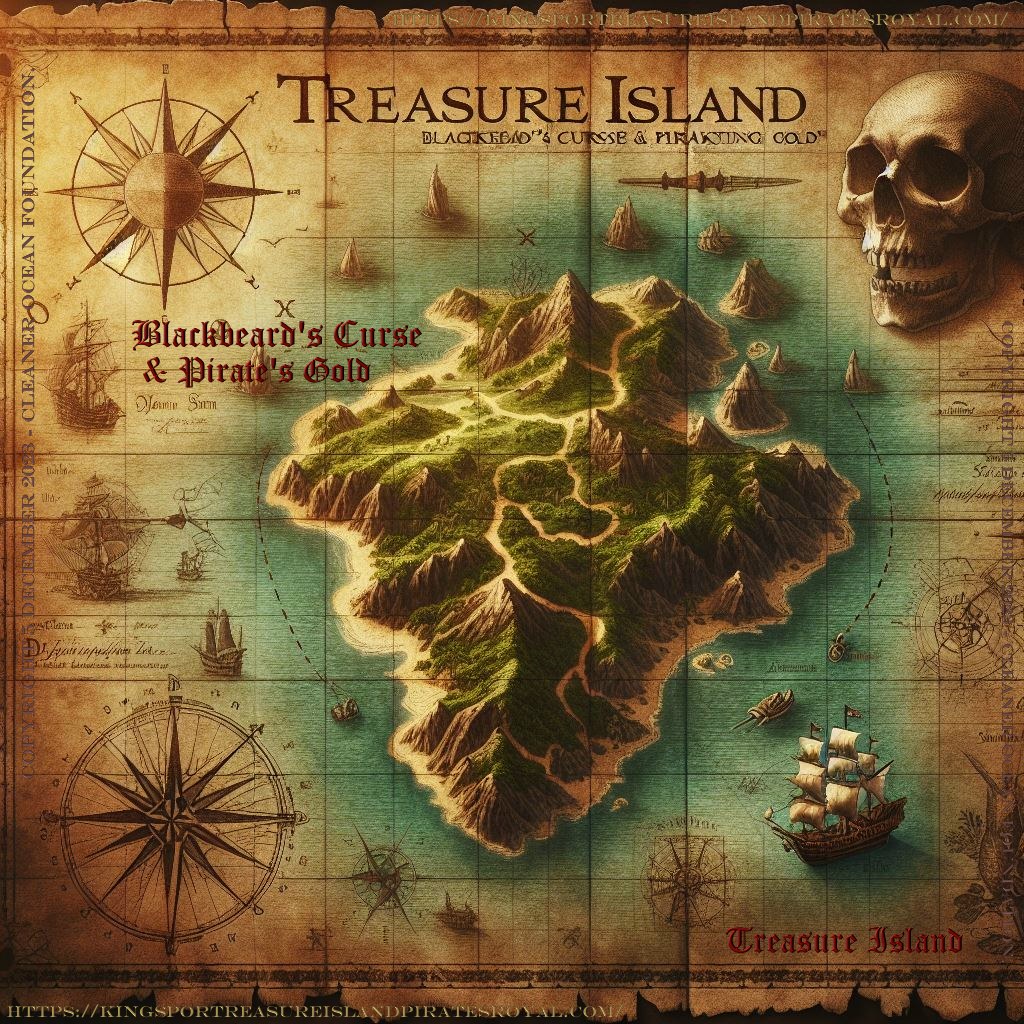
PIRATES
OF TORTUGA
Disney
made an excellent series of fantasy swashbuckler films based on the legendary haunt, Tortuga,
and piracy, a formula that made Errol Flynn famous as a privateer for Good
Queen Bess, romanticizing the plundering and treasure hunting, with
British Naval officers as some of the antagonists.
The series is intermingled with ghost ships and pirates, that are
cursed, relying heavily on CGI for effects - that are excellent in the
main, if a little overdone on the skeletal ghost front. A little goes a
long way!
The
key players of the Pirates of the Caribbean film
series are Johhny Depp as Captain Jack Sparrow,
Elizabeth Swann (Keira
Knightly)
and Geoffrey Rush as
Captain Hector Barbossa, with Orlando
Bloom as Will Turner.
Pirates
of the Caribbean was produced by Jerry
Bruckheimer and based on Walt Disney's theme park attraction of the
same name. The film series serves as a major component of the eponymous
media franchise.
Directors of the series include Gore
Verbinski (films 1–3), Rob Marshall (4),
Joachim Rønning (5–6),
and Espen Sandberg (5). The series is primarily written by
Ted Elliott
and Terry Rossio (1–4); other writers include Stuart Beattie (1), Jay Wolpert (1), Jeff Nathanson (5), Craig Mazin (6).
The stories follow the adventures of
Captain Jack Sparrow (Johnny Depp), Will Turner
(Orlando Bloom) and Elizabeth Swann (Keira Knightley). Characters such as Hector Barbossa (Geoffrey Rush) and Joshamee Gibbs
(Kevin McNally) follow Jack, Will and Elizabeth in the course of the films.
The fourth film features Blackbeard
(Ian McShane) and Angelica (Penélope
Cruz), while the fifth film features Armando Salazar (Javier
Bardem), Henry Turner (Brenton
Thwaites) and Carina Smyth (Kaya
Scodelario).
The films take place in a fictionalized historical setting; a world ruled by the
British
Empire, the East India Trading Company (based on the real East India Trading Company) and the Spanish Empire, with pirates representing freedom from the ruling powers.
The film series started in 2003 with Pirates of the Caribbean: The Curse of the Black Pearl, which received positive reviews from critics and grossed US$654 million worldwide.
After the first film's success,
Walt Disney Pictures revealed that a film series was in the works. The franchise's second film, subtitled Dead Man's Chest, was released three years later in 2006; the sequel proved successful, breaking financial records worldwide the day of its premiere.
Dead Man's Chest ended up being the number one film of the year upon earning almost $1.1 billion at the worldwide box office.
The third film in the series, subtitled At World's End, followed in 2007 earning $960 million, and Disney released a fourth film, subtitled On Stranger Tides, in 2011 in conventional 2D, Digital 3-D and IMAX 3D. On Stranger Tides succeeded in also grossing more than $1 billion, becoming the second film in the franchise and only the eighth film in history to achieve this.
The franchise has grossed over $4.5 billion worldwide; it is the 14th-highest-grossing film series of all time, and is the first film franchise to produce two or more movies that grossed over
$1
billion.
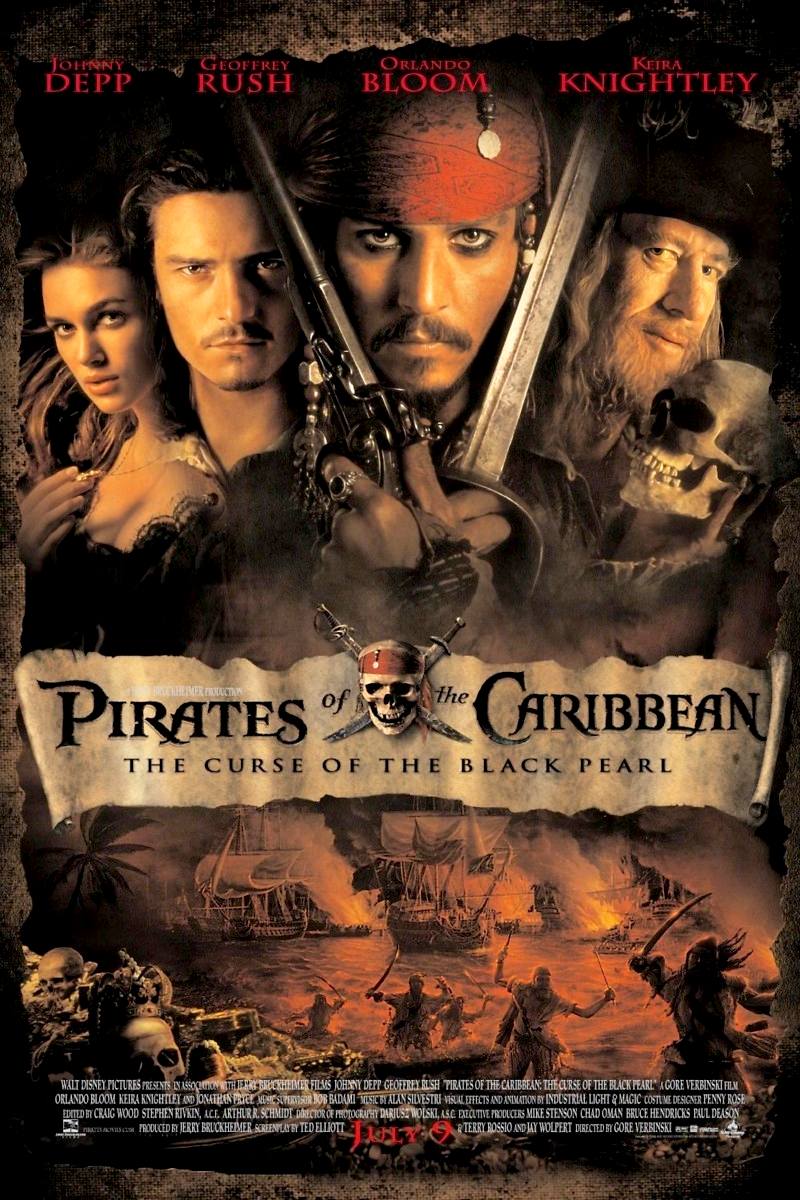
1. Pirates of the Caribbean: The Curse of the Black Pearl (2003)
Blacksmith Will Turner teams up with eccentric pirate Captain Jack Sparrow to save Turner's love, Elizabeth Swann, from cursed pirates led by Jack's mutinous former first mate, Hector Barbossa. Jack wants revenge against Barbossa, who left him stranded on an island before stealing his ship, the Black Pearl, along with 882 pieces of cursed Aztec Gold.
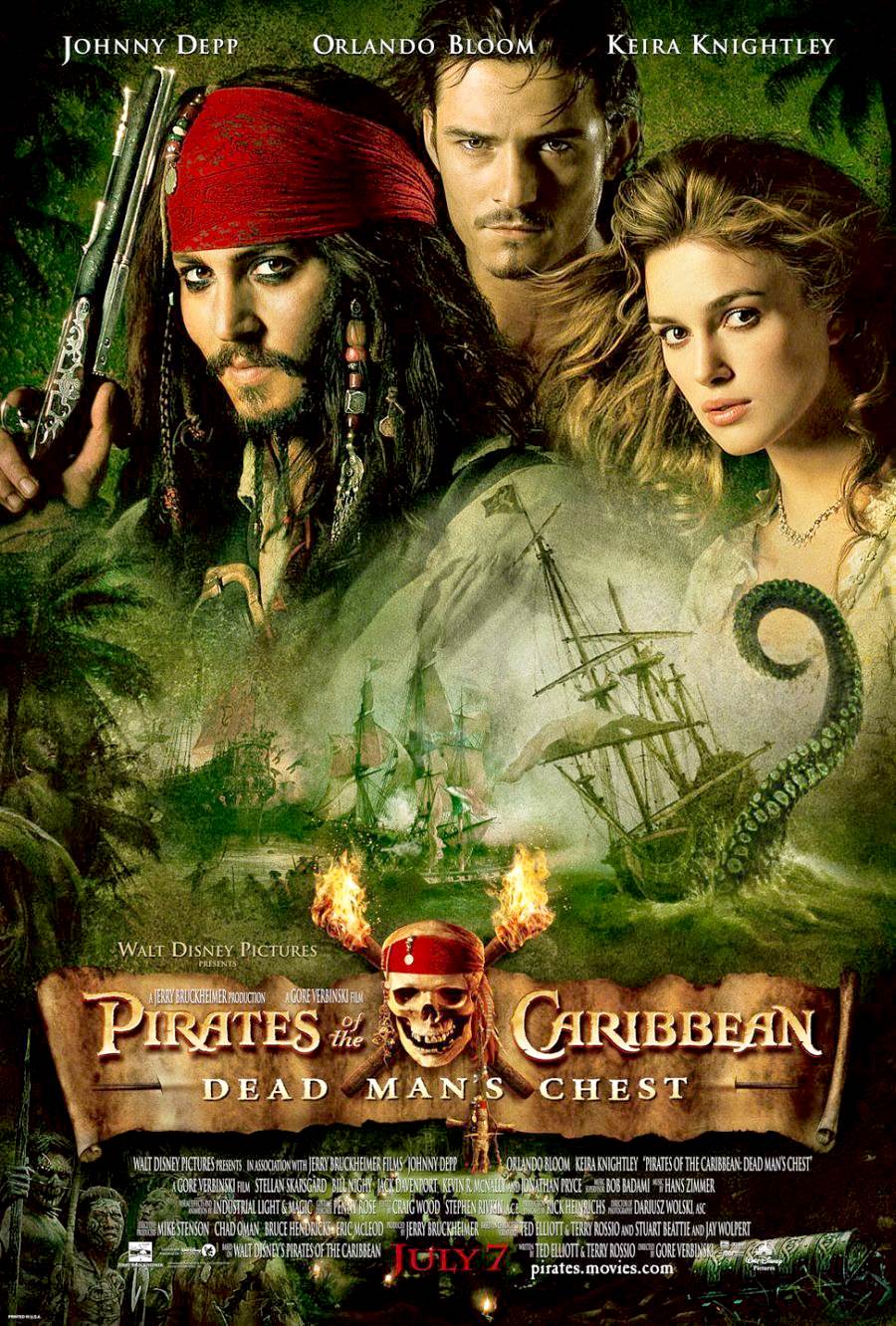
2. Pirates of the Caribbean: Dead Man's Chest (2006)
Lord Cutler Beckett of the East India Trading Company arrests Will and Elizabeth for aiding Captain Jack Sparrow in the previous film. Beckett offers clemency if Will agrees to search for Jack's
compass in a bid to find the Dead Man's Chest
- and inside, the heart of villainous Davy Jones - which would give Beckett control of the seas. However, Jack wants the Chest to escape from an unpaid debt with Jones, who made Jack captain of
the Black Pearl for 13 years in exchange for 100 years of service aboard Jones' ship,
the Flying Dutchman.
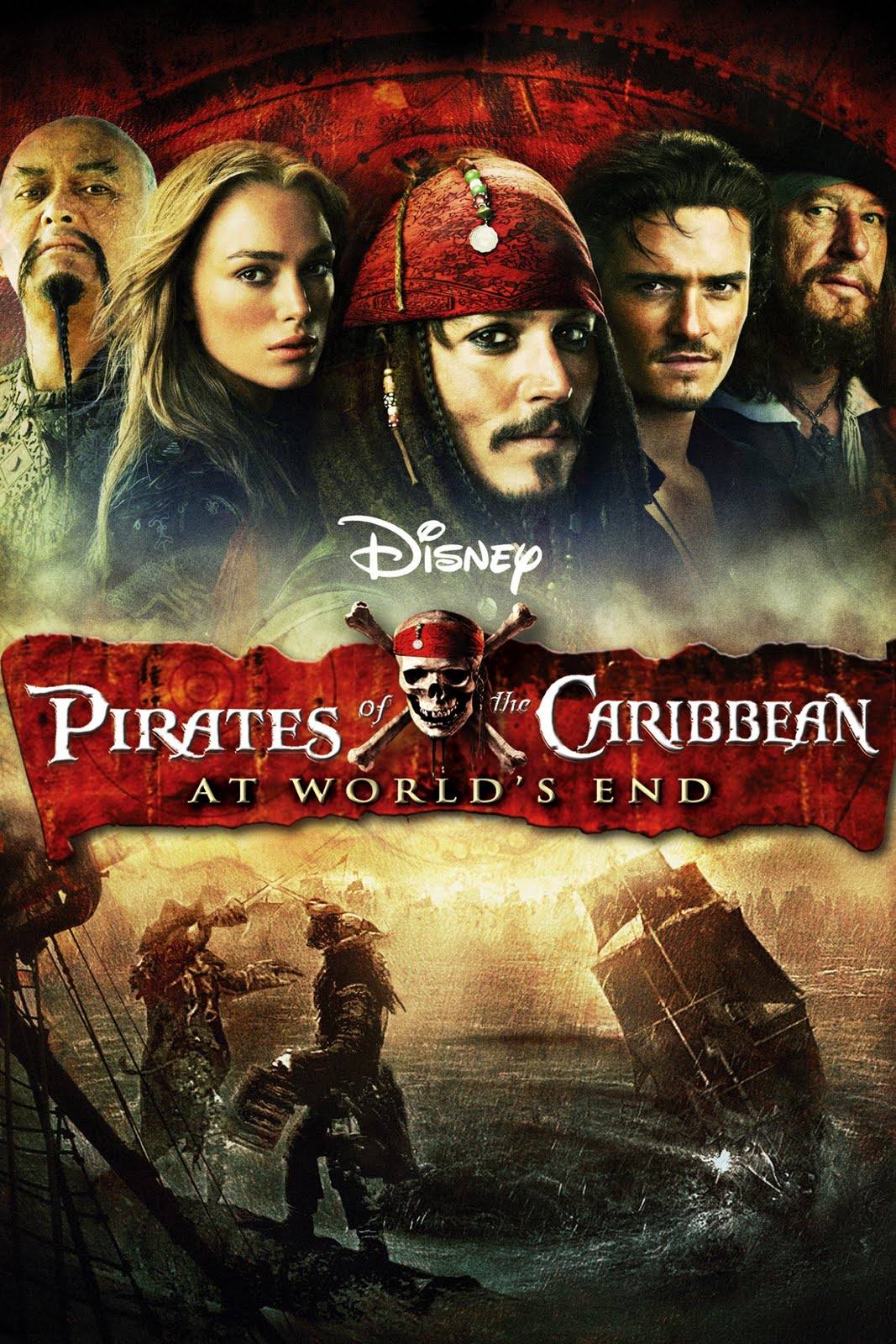
3. Pirates of the Caribbean: At World's End (2007)
Lord Beckett gains power over Davy Jones and, with the help of the Flying
Dutchman, he is now executing his plans to extinguish piracy forever. To stand against the East India Trading Co., Will, Elizabeth, Barbossa, and the crew of the Black Pearl set out to rescue Captain Jack Sparrow from Davy Jones' Locker. As one of the Nine Pirate Lords, Jack is needed in order to release an ancient goddess with the power to defeat Beckett's forces.
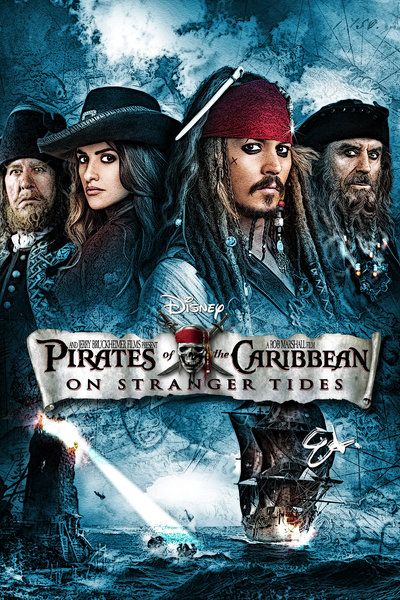
4. Pirates of the Caribbean: On Stranger Tides (2011)
Captain Jack Sparrow is on a quest to find the fabled Fountain of Youth and crosses paths with a former lover, Angelica. She forces Jack aboard the
Queen Anne's
Revenge, a ship captained by the infamous pirate Blackbeard, Angelica's father. Both are also in search of the Fountain: Angelica to save her father's soul, Blackbeard to escape a prophecy of his demise at the hands of a one-legged man. Joining the hunt is former pirate captain Barbossa, now a privateer in King George II's Navy, who is in a race against the Spanish for the Fountain of Youth.
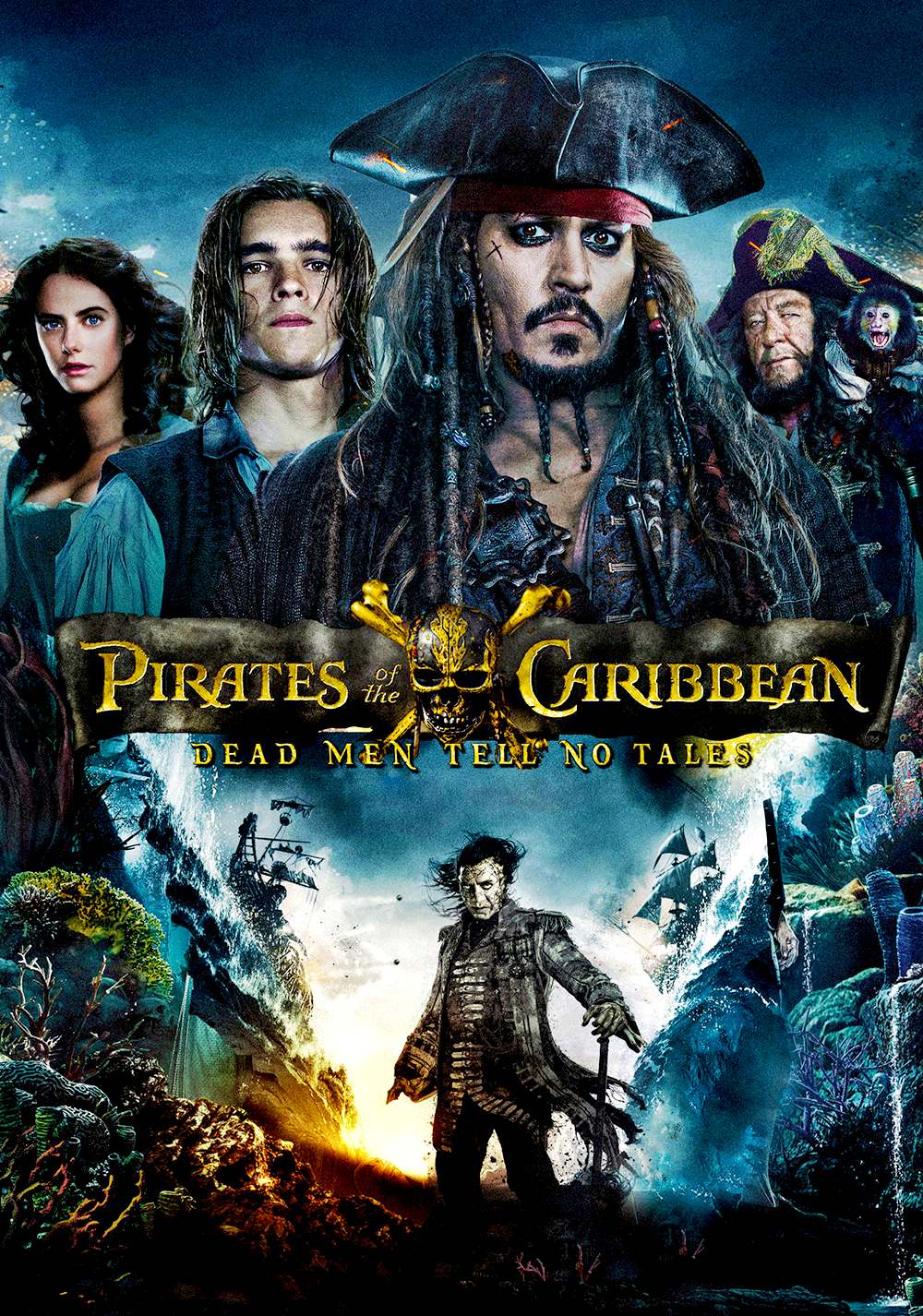
5. Pirates of the Caribbean:
Dead Men Tell No Tales (2017)
A group of ghostly Spanish Royal Navy soldiers led by Jack Sparrow's old nemesis, Captain Armando Salazar, escape from the Devil's Triangle, with the goal of killing every pirate at sea, including Sparrow. To survive, Sparrow seeks out the legendary Trident of Poseidon, a powerful artifact whose owner can control the seas, tides, aquatic animals and break curses.
6. Potential Sixth film
Shortly before the release of On Stranger Tides, it was reported that Disney was planning to shoot the fifth and the sixth films back-to-back, although ultimately only the fifth installment was developed. By March 2017, director Joachim Rønning stated that Dead Men was only the beginning of the final adventure, confirming that it would not be the last film of the series. In September 2017, producer Jerry Bruckheimer indicated that another Pirates of the Caribbean is still in development. In October of the same year, Kaya Scodelario stated that she is contractually signed to return for a sixth film. Shortly after, it was confirmed that Rønning will direct the film. In May 2020, there were reports that the studio were considering Karen Gillan, Daisy Ridley and Emma Watson for the female lead, while Bruckheimer commented that the first draft of the screenplay for the sixth film would soon be finished, adding that he was "unsure" of Depp's role in the movie.
7. Potential Spin-off film
In June 2020, it was announced that Disney was developing a female-led spin-off with Christina Hodson set to pen the screenplay and Margot Robbie attached to star. The film will be a separate from the sixth film currently being developed. Jerry Bruckheimer will also be attached to the project as producer.
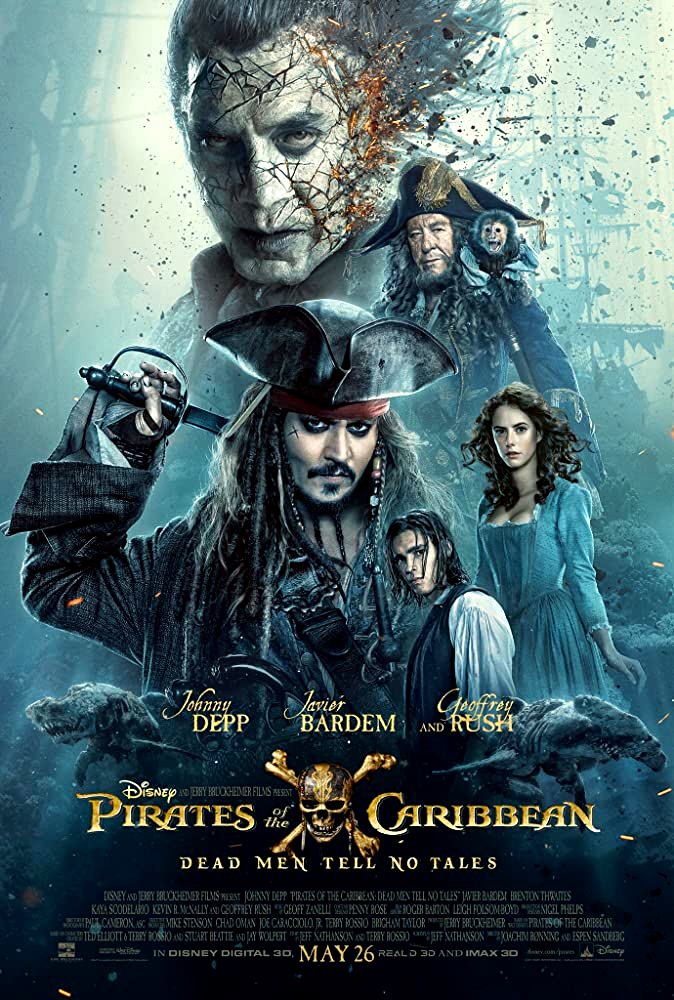
BOX OFFICE
1. The Curse of the Black Pearl July 9, 2003 $654,264,015 - Budget: $140 million
2. Dead Man's Chest July 7, 2006 $1,066,179,725 - Budget: $225 million
3.
At World's End May 25, 2007 $963,420,425 - Budget: $300 million
4.
On Stranger Tides May 20, 2011 $1,045,713,802 - Budget: $378.5 million
5.
Dead Men Tell No Tales May 26, 2017 $794,780,215 - Budget: $230 million
Total
Revenue: $4,524,358,182 - Budget $1.274 billion
Not
bad!
A
BIT OF PIRATE HISTORY
Pirates have existed since ancient times – they threatened the trading routes of ancient Greece, and seized cargoes of grain and olive oil from Roman ships. The most far-reaching pirates in early medieval Europe were the Vikings.
A life of Piracy on the high seas tempted poor seamen because it offered them the chance to take more control of their
lives and adventure. Ordinary seamen toiled for modest wages and were subject to strict discipline. In contrast, piracy offered sailors a chance to get rich quick as
equals or at least shareholders of captured booty.
ENGLISH SEA DOGS, PRIVATEERS
English Sea Dogs were pirates that sailed during the Privateering Era under the leadership of
Queen Elizabeth I between 1560 and 1605. During this time they had explicit permission from the Queen known as a Letter of Marque which allowed them to engage in acts of piracy against the Spanish and other colonial powers the English were at war with at the time.
One of the first well known English Sea Dogs would be John Hawkins who began in the mid 16th century. Hawkins would also be engaged in the slave trade as part of the Trans-Atlantic Triangular Trade. Another famous Sea Dog was
Francis Drake who raided Spanish settlements all across the world. One of Drakes most famous exploits was to sail around to the Pacific Coast and raid Spanish settlements before returning to England, completing his second
circumnavigation of the globe.
In 1588 the famous English Sea Dogs named Francis Drake, John
Hawkins, Walter Raleigh and Martin Frobisher were all part of the English naval forces that helped defeat the Spanish Armada and challenge Spanish naval
dominance. In 1604 when peace was made with Spain many of the Sea Dogs went to work in the Barbary States.
Overall the English Sea Dogs were responsible for striking great blows against the Spanish Main. Eventually they would be replaced by the English Buccaneers who operated throughout the Buccaneering Era and helped manage to establish actual colonies for the British Empire throughout the West Indies.
CORSAIRS
Corsairs were pirates who operated in the Mediterranean Sea between the 15th and 18th centuries. Muslim corsairs, such as the Barbarossa (red beard) brothers, had bases along North Africa’s Barbary Coast, while Christian corsairs were based on the island of Malta. Both used to swoop down on their targets in oar-powered boats called galleys, to carry off sailors and passengers. Unless these unfortunates were rich enough to pay a ransom, they were sold as slaves.
BUCCANEERS
Thousands of pirates were active between 1650 and 1720, and these years are sometimes known as the 'Golden Age’ of piracy. Famous pirates from this period include
Henry
Morgan, William 'Captain' Kidd, 'Calico' Jack Rackham, Bartholomew Roberts and the fearsome Blackbeard (Edward Teach).
By the beginning of the 18th century, piracy was becoming hard work. The Spanish galleons no longer plied the oceans with chests full of dubloons, and responsible governments with large navies were getting tired of pirates preying on their vessels.
Still, there was a living to be made by those who were prepared to take
risks. The famous pirate Blackbeard (Edward Teach) plundered successfully for nearly three years until, in a hand-to-hand fight with Lieutenant Maynard of the H.M.S. Pearl, he
was taught the difference between swinging a cutlass brutally and skill and
training with a blade. Twenty-five wounds later, Blackbeard expired on the deck.
In 1717, George I offered a general amnesty to all pirates who surrendered themselves before 5th September of the following year. Many members of the profession
decided to quit while ahead and settled down to become respectable citizens. There were a few
pirates who could not change their lives of piratical adventure. They were hunted down ruthlessly
until by 1725 it was just about over.
FRENCH
BUCCANEERS
French buccaneers were famous pirates of the Buccaneering Era that were from the French Empire. These buccaneers were responsible for establishing the first French colony in the New World in Spanish controlled La Florida that was known as Saint Caroline. However, this settlement of French huguenots was wiped out by the Spanish under the command of Pedro Menendez de Aviles who assaulted them from nearby Saint Augustine.
After this defeat the French buccaneers moved to the rocky outcrop island of Tortuga off the coast of Hispaniola and established
the famous pirate haven. They would clash with the Spanish for many decades and eventually be successful in not only claiming Tortuga but
a third of the island of Hispaniola as well that the French named Saint-Dominigue.
French buccaneers were just as famous as their English or Dutch counterparts.
Buccaneers lived on the Caribbean island of Hispaniola and its tiny turtle-shaped neighbour, Tortuga, in the 17th century. At first they lived as hunters, but later the governors of Caribbean islands paid the buccaneers to attack Spanish treasure ships. Although raids began in this way, with official backing, the buccaneers gradually became out of control, attacking any ship they thought carried valuable cargo, whether it belonged to an enemy country or not. The buccaneers had become true pirates.
Privateers, meanwhile, were privately owned (rather than navy) ships armed with guns, operating in times of war.
17th century pirates were also known as buccaneers and operating mostly during the Buccaneering Era. Called boucaniers, the English term 'buccaneers', these groups of French and English pirates would raid Spanish settlements and ships alike in a state sponsored piracy campaign.
The buccaneers of the 17th century were generally more ruthless, and merciless than the 18th century pirates.
Operating out of their bases at Port Royal and Tortuga, the 'Brethren of the Coast' were not pirates in the sense they were conquerors. Buccaneers raided ships at sea when it was convenient for them but they also had massive armies with which they would militarily take out Spanish troops and invade settlements from the land. They were known for sacking and ransoming cities,
but there total take was a lot less than the 18th century pirates in that they had more men to split the loot with.
Most of the exploits of the buccaneers are only known about through the
writings of the surgeon aboard Henry Morgan's ship named Alexander Exquemelin. His primary source book first published in Dutch as De Americaensche Zee Roovers (1678),
known in English as the 'Buccaneers of America,' is one of the best documents
to understand the biographical story of the buccaneers.
Maties, please use our A-Z to
navigate this site or return HOME
me
hearties.






